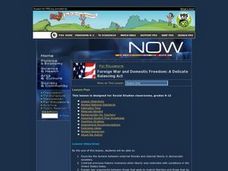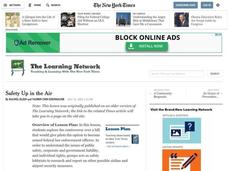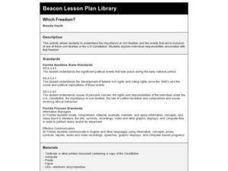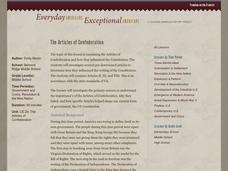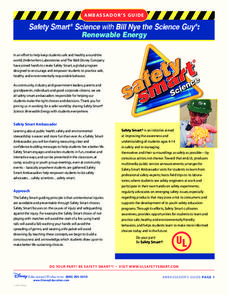Curated OER
Follow a Bill!
Students discover how a bill becomes a law. In this Legislative Branch lesson plan, students watch C-Span coverage of a bill making its way through the House and the Senate. Students use the provided worksheet to chart the progress of...
Curated OER
How a Bill Becomes a Law
Students make a chart on what they learned about how a bill becomes a law. In this law making lesson plan, students research the authority and restrictions placed on Congress on how they make a bill into a law and then present their...
Curated OER
Lesson Two: The Federalist Papers
Students identify Articles of Confederation and explain why it failed, explain argument over need for Bill of Rights in Constitution and James Madison's role in securing it's adoption, and compare and contrast ideas of Federalists and...
Curated OER
Foreign War and Domestic Freedom: A Delicate Balancing Act
Students investigate civil liberties in the U.S. They watch and discuss a PowerPoint presentation, conduct research on an event from a timeline, complete a worksheet, take an ideology quiz, and conduct a debate.
Curated OER
The Right Choice
Students examine the leadership role of George Washington in the American Revolution. For this George Washington lesson, students read selections titled "Generalship," and "Candidate for Commander-in-Chief." After students read the...
Curated OER
South Carolina Voices: Lessons from the Holocaust
Students read and summarize two different articles that are based on anit-Semitism. In this Holocaust lesson, students discuss if events in the articles could happen in today's society or not.
Curated OER
Safety Up in the Air
Students explore the controversy over a bill giving pilots the option to become armed federal law enforcement officers. They brainstorm other possible security measures for airplanes and airports.
Curated OER
Declaration of Independence
Students explore the US Constitution. In this Bill of Rights lesson, students work in pairs to select and examine amendments to the Bill of Rights. Students will identify what the amendment means, why they chose it, what it protects, and...
Curated OER
How Women Won the Right to Vote
Students consider how women gained the right to vote in America. In this suffrage lesson, students investigate major events of the suffrage movement and conduct research. Students also role play petitioning to President Wilson to get the...
George Washington's Mount Vernon Estate & Gardens
George Washington: Centerpiece of a Nation
A neat Presidents Day activity, this lesson provides a culminating learning experience for upper elementary aged learners. After analyzing George Washington's, "A Display of the United States of America," your learners will conduct...
Curated OER
In His Own Words: James Madison On the Problem of Faction
Students are introduced to the writings of James Madison and explain why he is often called "The Father of the Constitution". Using primary source documents, they examine his view of the Bill of Rights and what he meant by faction. In...
Curated OER
Symbolic Speech
Ninth graders consider the right of freedom of speech as it is outlined in the U.S. Constitution. They receive background information for the US Supreme Court, the Bill of Rights, and free speech. They discuss a series of actual cases...
Curated OER
In the Light of Reverence
Students watch a documentary prior to participating in a Supreme Court simulation in order to study how religious practices are protected by the First Amendment of the Constitution. They interpret conflict from a number of perspectives...
Curated OER
My Secret War: The WWII Diary of Madeline Beck: Lesson 6
Fifth graders explore women's rights by discussing the events of WWII. In this American work force lesson, 5th graders identify the events that led to World War II and how women helped fight the war through non-violent efforts. Students...
Curated OER
Teaching With Documents: U.S. Constitution Workshop
What does it mean to be American? Explore the constitution and what it really means to be a citizen here. First, learners of all ages will investigate different primary source documents. Then, they establish each document's...
Curated OER
Citizen Juries: Zacarias Moussaoui - May 1, 2006
Young scholars consider deliberations by juries. For this citizen jury lesson, students complete readings regarding the constitutional right to a trial by jury as well as on the civic responsibility to serve on a jury.
Curated OER
The Role of the Independent Counsel
High schoolers analyze the role of independent counsel. In this Bill of Rights lesson, students listen to their instructor present a lecture regarding Watergate, Impeachment, and the role of independent counsel. High schoolers respond to...
Curated OER
Which Freedom?
Fourth graders choose on the freedoms in the Bill of Rights and research it on the internet. They answer specific questions using their research and produce a written document using a computer.
National Endowment for the Humanities
Magna Carta: Cornerstone of the U.S. Constitution
High schoolers use the Internet to read a brief description of Magna Carta (link provided). They "walk through" the document with the teacher, identifying four major themes. High schoolers read and discuss "The Rhetoric of Rights:...
Advocates for Human Rights
U.S. Immigration Policy
The United States Immigration Policy is incredibly complex. To gain a deeper understanding of the criteria, quotas, preferences, and categories of immigrants admitted to the US, class members engage in a role playing activity that...
School Improvement in Maryland
Dividing the Powers of Government
Who does what? To develop an understanding of the balance of power between the US federal and state governments, class members research responsibilities in terms of legal systems, security issues, economic activities, lawmaking, and...
Roy Rosenzweig Center for History and New Media
The Articles of Confederation
Have you ever started a project only to realize you need to scrap it and start over? Scholars analyze the issues leading to the fall of the Articles of Confederation. A group investigation into Articles II, III, and VIII unveil the...
Disney
Renewable Energy
Bring some energy to your physical science curriculum with this engaging Bill Nye the Science Guy lesson. Based on his Renewable Energy video, students explore the concepts of potential and kinetic energy and learn how they are applied...
Judicial Branch of California
The Power of the Press: The First Amendment
Was what happened in 1886 at the Haymarket riot a crime or a case of xenophobia? Using political cartoons from the time, young historians consider the role the media played in anti-labor sentiment during the time and how that influenced...





